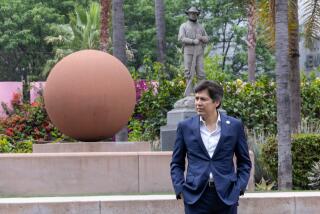A Question of Honor, History and Equality
- Share via
RICHMOND, Va. — Monument Avenue is Richmond’s grandest boulevard. Wide and tree-lined, it cuts a path through the symbolic heart of Dixie and on its median stand towering statues of Confederate legends: Robert E. Lee, Jefferson Davis, Stonewall Jackson, Jeb Stuart.
Depending on one’s sentiments in this former capital of the Confederacy, Monument Avenue is either the “Boulevard of Heroes” or “Losers Lane.” But no new statue has gone up there in 75 years, and few would dispute the notion that to be memorialized on the avenue is to join Richmond’s most exclusive fraternity.
That is Richmond’s dilemma: How does the city honor its most famous modern-day son, the late Arthur Ashe, a black tennis star who left segregated Richmond in 1961 and became a champion for racial equality? Should his statue, now nearing completion, be placed on Monument Avenue alongside those of white Civil War leaders who fought for slavery?
After nearly a year of bickering and charged public debate, Richmond still doesn’t have the answer. Some whites, a minority, want Monument Avenue left as a Confederate preserve; other residents believe Ashe’s statue there would send a message that Richmond had moved beyond its obsession with the Civil War and had entered a new age; many think Ashe deserves a place of his own elsewhere in the city. Only on one point does every agree: Ashe was an extraordinary human being who should be memorialized somewhere in Richmond.
“When I decided to leave Richmond,” Ashe once wrote, having been denied access to the city’s white-only tennis courts, “I left all that Richmond stood for at the time--its segregation, its conservatism, its parochial thinking, its slow progress toward equality, its lack of opportunity for talented black people. I had no intention of coming back.”
Ashe, who died in 1993 at age 49 of complications of AIDS, contracted from a blood transfusion following surgery, later reconciled with Richmond, a city that today is very different from the one he left in disgust. The white aristocracy has given way to a population and a City Council that have a black majority. The mayor, city manager, police chief and fire chief are black.
Shortly before his death, Ashe approved a proposal for a statue, although a site wasn’t discussed at the time. The $400,000 statue would be paid for by the Virginia Heroes Foundation, a nonprofit organization Ashe started in 1990. A Richmond sculptor, Paul DiPasquale, went to work and produced a statue that is now ready for bronzing: a 12-foot-high Arthur Ashe in an athletic warm-up suit, his right hand holding three books aloft, his left, a tennis racket. Four children are at his feet on a granite base.
“It is Arthur,” his cousin Randy Ashe said of the statue. “It also carries his message--children, knowledge and discipline.”
At a crowded seven-hour hearing in July, at which a few spectators turned up in Civil War garb and a few others in African dress, the City Council voted 8 to 0 for the Monument Avenue location, saying it had been swayed by testimony of Ashe family members who favored the site. Ground was broken in August at Monument Avenue and Roseneath Road.
“The Rubicon has been crossed,” said former Virginia Gov. Douglas Wilder, the nation’s first black governor since Reconstruction. “Arthur Ashe will be forever enshrined in the pantheon.”
But some Richmonders have continued to try to torpedo the site. “Those damn generals were villains,” said Ray Boone, publisher of the minority-owned Richmond Free Press. “They tried to destroy the nation in the name of saving slavery. Arthur Ashe soared far above these people. He stood for liberty, not subordination.”
Then during New Year’s weekend, Ashe’s widow, Jeanne Moutoussamy-Ashe, who lives in New York and had remained silent during the controversy, surprised everyone by sending an unsolicited statement to the Richmond Times-Dispatch, saying Ashe had agreed to the statue, thinking it would be placed near a proposed African American Sports Hall of Fame. On top of that, she said, she opposed the Monument Avenue site.
Stunned, the City Council put the issue under review--again. Finally, last Monday the city planning commission formally recommended that DiPasquale’s statue of Ashe be placed on Monument Avenue temporarily, then be moved to the site of the proposed sports hall of fame. A competition will be held to select a new Ashe statue that eventually will stand permanently on Monument Avenue.
Although some saw the whole debate as an example of racial separateness, Thomas Chewning thinks the end of the controversy means precisely the opposite. Chewning, a white Richmond tennis star, befriended Ashe as a teenager and led the campaign for an Ashe statue.
“The real precedent is that the debate whether an African American can take his place in an esteemed part of the city is over, and the answer is yes,” Chewning said. “The City Council decided that in its original vote and most people went along. What Richmond said was, yes, Arthur Ashe is worthy to be on Monument Avenue.”
Times researcher Edith Stanley of the Atlanta bureau contributed to this story.
More to Read
Sign up for Essential California
The most important California stories and recommendations in your inbox every morning.
You may occasionally receive promotional content from the Los Angeles Times.












